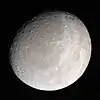ထရီတွန် (ဂြိုဟ်ရံလ)
နက်ပကျွန်းဂြိုဟ်၏ အကြီးဆုံးသော လအမည်မှာ ထရီတွန် (Triton) ဖြစ်သည်။ ၎င်းသည် နေအဖွဲ့အစည်း၏ ခုနှစ်ခုမြောက် အကြီးဆုံးလတစ်စင်းဖြစ်သည်။ ထရီတွန်သည် အာကာသဆိုင်ရာ မှတ်တမ်း၊ ရာဇဝင်များဖြင့် ရှုပ်ထွေးနေပြီး ၎င်း၏ သစ်လွင်သော မျက်နှာပြင်နှိုင်းယှဉ်ချက်တစ်ခုကို နေအဖွဲ့အစည်း၏ သက်တမ်းနှင့် နှိုင်းယှဉ်ကြည့်ရန်တွေးခဲ့ကြသည်။[11][12] ဂျာမန်နက္ခတ္တဗေဒပညာရှင်များဖြစ်ကြသည် ဂျိုဟန် ဂေါ့ဖရန့် ဂယ်လီနှင့် ဟိန်းရစ်ချ် လူးဝစ်တအာရက်တို့ နှစ်ဦးသည် နက်ပကျွန်းဂြိုဟ်အား ရှာဖွေတွေ့ရှိပြီး[11] ၁၇ ရက်အကြာတွင် ၎င်းနက်ပကျွန်းဂြိုဟ်၏ ဂြိုဟ်ရံ လကြီးကို ဗြိတိန်နက္ခတ္တဗေဒပညာရှင် ဝီလျံ လောစီ က ၁၈၄၉ ခုနှစ်၊ အောက်တိုဘာလ ၁၀ ရက်နေ့တွင် ရှာဖွေတွေ့ရှိခဲ့သည်။[11][11]ထရီတွန်သည် Kuiper belt ဟုခေါ်သည့် နတ်ပကျွန်းဂြိုဟ်မှ ထွက်လာသည့် လမ်းကြောင်းအတွင်း ဖမ်းယူခြင်းခံရသည့် ဂြိုဟ်တစ်လုံးဖြစ်သည့်အပြင် နေအဖွဲ့အစည်းတွင် အအေးဆုံးသော ဂြိုဟ်တစ်ခုဖြစ်ရမည်ဟု အချို့ကတွေးတောကြသည်။ ထရီတွန်၏ မျက်နှာပြင်အပူချိန်အား ဗွိုင်ယေဂျာ ၂ ဖြင့် မှတ်တမ်းတင်ထားရာတွင် -၂၃၅ ဒီဂရီ ဆယ်လ်ဆီးယပ် အထိ အေးသည်ဟု သိရသည်။
.jpg.webp) Voyager 2 photomosaic of Triton[caption 1] | |
| ရှာဖွေတွေ့ရှိခြင်း | |
|---|---|
| ရှာဖွေတွေ့ရှိခဲ့သူ | William Lassell |
| ရှာဖွေတွေ့ရှိသည့် ရက်စွဲ | October 10, 1846 |
| အသံထွက် | /ˈtraɪtən/ |
အခြားအမည်များ | Neptune I |
| ပါဝင်အရာဝတ္ထုများ | Tritonian |
| ပတ်လမ်း ဂုဏ်အင်များ | |
ဆီမီး မေဂျာ ဝင်ရိုး | 354759 km |
| ပတ်လမ်း ဗဟိုကျမှု | 0.000016[1] |
ပတ်လမ်း ကာလ | 5.876854 d (retrograde)[1][2] |
ပျမ်းမျှ ပတ်နှုန်း | 4.39 km/s |
| ပတ်လမ်း တိမ်းစောင်းမှု | 129.812° (to the ecliptic) 156.885° (to Neptune's equator)[3][4] 129.608° (to Neptune's orbit) |
| ဂြိုဟ်ရံလများ | နက်ပကျွန်းဂြိုဟ် |
| ရုပ်ပိုင်းဆိုင်ရာ ဂုဏ်အင်များ | |
ပျမ်းမျှ အချင်းဝက် | 1353.4±0.9 km[5] (0.2122 Earths) |
မျက်နှာပြင် ဧရိယာ | 23018000 km2[lower-alpha 1] |
| ထုထည် | 10384000000 km3[lower-alpha 2] |
| အရွယ်အစား | 2.14×1022 kg (0.00359 Earths)[lower-alpha 3] |
ပျမ်းမျှ သိပ်သည်းဆ | 2.061 g/cm3[5] |
မျက်နှာပြင် ဒြပ်ဆွဲအား | 0.779 m/s2 (0.0794 g) (0.48 Moons)[lower-alpha 4] |
လွတ်မြောက်အလျင် | 1.455 km/s[lower-alpha 5] |
လှည့်ပတ်ကာလ | synchronous |
ဘေးဘက် လှည့်ပတ်ကာလ | 5 d, 21 h, 2 min, 53 s[6] |
ဝင်ရိုးတိမ်းစောင်းမှု | 0 |
| Albedo | 0.76[5] |
| အပူချိန် | ၃၈ ကယ်လ်ဗင် (−၂၃၅.၂ ဒီဂရီ စင်တီဂရိတ်)[6] |
မြင်သာသော အရွယ်အစား | 13.47[7] |
ပကတိ အရွယ်အစား (H) | −1.2[8] |
| လေထု | |
မျက်နှာပြင် လေထုဖိအား | 1.4–1.9 Pa[6] (1/70000 the surface pressure on Earth)[9] |
| လေထု၌ ဓာတုပါဝင်နှုန်း | နိုက်ထရိုဂျင်၊ မီသိန်း traces.[10] |
ယခုချိန်တွင်ထရီတွန်သည် အနိမ့်ပိုင်းပတ်လမ်းသို့ ကျရောက်နေသည်ဟုလည်း ဆိုကြသည့်အပြင် နှစ်သန်း ၁ထောင် ခန့်တွင် ထရီတွန်သည် တစ်ခုခုနှင့် ထိခိုက်မိ၍ နက်ပကျွန်းဂြိဟ်၏ လေထုလွှာတွင်းသို့ သက်ဆင်းရမည်သို့မဟုတ် စေတန်ဂြိုဟ်၏ ဂြိုဟ်ပတ်ကွင်းစနစ် (Ring System)နှင့် ဆင်တူသည့် စနစ်အတွင်းတွင် ပျက်သုဉ်းလိမ့်မည်ဟု သိပ္ပံပညာရှင်များက သုံးသပ်ကြလေသည်။
မှတ်စု
- Photomosaic of Triton's sub-Neptunian hemisphere. The bright, slightly pinkish, south polar cap at bottom is composed of nitrogen and methane ice and is streaked by dust deposits left by nitrogen gas geysers. The mostly darker region above it includes Triton's "cantaloupe terrain" and cryovolcanic and tectonic features. Near the lower right limb are several dark maculae ("strange spots").
- Surface area derived from the radius r: .
- Volume v derived from the radius r: .
- Mass m derived from the density d and the volume v: .
- Surface gravity derived from the mass m, the gravitational constant g and the radius r: .
- Escape velocity derived from the mass m, the gravitational constant g and the radius r: .
ကိုးကား
- Williams, David R. (November 23, 2006)။ Neptunian Satellite Fact Sheet။ NASA။ October 5, 2011 တွင် မူရင်းအား မော်ကွန်းတင်ပြီး။ January 18, 2008 တွင် ပြန်စစ်ပြီး။
- Overbye၊ Dennis။ "Bound for Pluto, Carrying Memories of Triton"၊ New York Times၊ November 5, 2014။ November 5, 2014 တွင် ပြန်စစ်ပြီး။
- Jacobson, R. A. — AJ (April 3, 2009)။ Planetary Satellite Mean Orbital Parameters။ JPL satellite ephemeris။ JPL (Solar System Dynamics)။ October 5, 2011 တွင် မူရင်းအား မော်ကွန်းတင်ပြီး။ October 26, 2011 တွင် ပြန်စစ်ပြီး။
- Jacobson, R. A. (3 April 2009). "The Orbits of the Neptunian Satellites and the Orientation of the Pole of Neptune". The Astronomical Journal 137 (5): 4322–4329. doi:. Bibcode: 2009AJ....137.4322J.
- Planetary Satellite Physical Parameters။ JPL (Solar System Dynamics)။ January 18, 2010 တွင် မူရင်းအား မော်ကွန်းတင်ပြီး။ October 26, 2011 တွင် ပြန်စစ်ပြီး။
- McKinnon၊ William B.; Kirk၊ Randolph L. (2014)။ "Triton"။ in Tilman Spohn; Doris Breuer; Torrence Johnson (eds.)။ Encyclopedia of the Solar System (3rd ed.)။ Amsterdam; Boston: Elsevier။ pp. 861–882။ ISBN 978-0-12-416034-7။
- Classic Satellites of the Solar System။ Observatorio ARVAL။ August 25, 2011 တွင် မူရင်းအား မော်ကွန်းတင်ပြီး။ September 28, 2007 တွင် ပြန်စစ်ပြီး။
- Fischer၊ Daniel (February 12, 2006)။ Kuiperoids & Scattered Objects။ Argelander-Institut für Astronomie။ October 5, 2011 တွင် မူရင်းအား မော်ကွန်းတင်ပြီး။ July 1, 2008 တွင် ပြန်စစ်ပြီး။
- Neptune: Moons: Triton။ NASA။ October 5, 2011 တွင် မူရင်းအား မော်ကွန်းတင်ပြီး။ September 21, 2007 တွင် ပြန်စစ်ပြီး။
- "Ultraviolet Spectrometer Observations of Neptune and Triton" (1989). Science 246 (4936): 1459–66. doi:. PMID 17756000. Bibcode: 1989Sci...246.1459B.
- NASA: Solar System Exploration: Planets: Neptune: Moons: Triton။ NASA။ 2011-03-29 တွင် ပြန်စစ်ပြီး။
- BBC Home: Science: Space: Solar System: Moons: Triton။ BBC။ 2011-03-29 တွင် ပြန်စစ်ပြီး။
